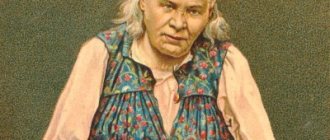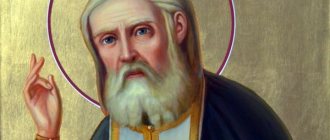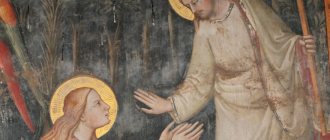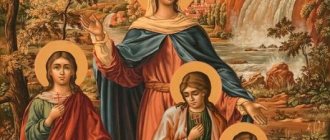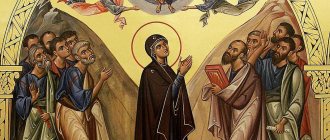On Wikipedia there are articles about other people with the name Marfa and the surname Milyukov.
| Marfa Diveevskaya | |
| Name in the world | Maria Semyonovna Milyukova |
| Born | February 10, 1810 (1810-02-10) village of Pogiblovo (now Malinovka) Ardatovsky district, Nizhny Novgorod province, Russian Empire |
| Died | August 21, 1829 (1829-08-21) (19 years old) Seraphim-Diveevsky Monastery |
| Monastic name | Marfa |
| Revered | in the Russian Orthodox Church |
| In the face | reverends |
| Main shrine | relics in the Diveyevo Monastery |
| Day of Remembrance | August 21 (September 3), in the Cathedral of Diveyevo Saints and in the Cathedral of Nizhny Novgorod Saints |
| Proceedings | construction of a church in the name of the Nativity of the Blessed Virgin Mary[1] |
| Asceticism | obedience, unceasing prayer |
Marfa Diveevskaya
(in the world -
Maria Semyonovna Milyukova
; February 10, 1810, village of Pogiblovo, Nizhny Novgorod province - August 21, 1829, Diveyevo monastery) - schema-nun, spent six of the nineteen years of her life in the Diveyevo monastery. The Monk Seraphim of Sarov revered her and said that she was the leader of the Diveyevo orphans in the Kingdom of Heaven[1]. She was glorified by the Council of Bishops of the Russian Orthodox Church in 2004 as a saint.
The memory is celebrated on August 21 (September 3), as well as in the Cathedral of Diveyevo Saints and in the Cathedral of Nizhny Novgorod Saints.
Biography[ | ]
Childhood[ | ]
Reverend Martha (in the world Maria Semyonovna Milyukova) was born on February 10, 1810 in a family of peasants in the Nizhny Novgorod province of Ardatov district, the village of Pogiblovo. The village is located near the village of Diveevo[2] and is currently called Malinovka.
The Milyukov family led a righteous and godly life and was close to Elder Seraphim of Sarov. Maria had an older sister, Praskovya Semenovna, and a brother, Ivan Semenovich.
With the blessing of St. Seraphim, the elder sister, Praskovya Semyonovna, was the first to enter the Diveyevo community and began to lead a life assessed according to the criteria of the Orthodox faith as highly spiritual.[3]
Ivan Semyonovich often went to Father Seraphim to work, and after the death of his wife he entered the Sarov Hermitage as a monk.[4]
Admission to the Diveyevo Kazan community[ | ]
On November 21, 1823, on the feast of the Entry into the Temple of the Most Holy Theotokos, thirteen-year-old Maria first came to Father Seraphim together with her sister Praskovya. The elder, “seeing her as the chosen vessel of God’s grace”
[3], did not allow her to return home, ordering her to remain in the Diveyevo community at the Kazan Church.
The young woman began asceticism from an early age, distinguished by the severity of her life and the severity of her feat, surpassing the exploits of the sisters of the community.[3] She constantly prayed. She answered meekly and only to the necessary questions. She was almost silent. Elder Seraphim initiated her into all his revelations, the future glory of the monastery and other spiritual secrets.[5]
Beginning of the Mill Community[ | ]
Soon after this, a new appearance of the Most Holy Theotokos occurred to St. Seraphim with the command to create a new community, a maiden community, next to the Kazan community. She was the beginning of the monastery promised by the Mother of God to Mother Alexandra.
Two weeks after the appearance of the Mother of God, namely on December 9, 1825, Mary and one sister came to the Monk Seraphim. The elder led them into the distant desert, taking with him wax candles, oil, and crackers. Arriving there and standing in front of the Crucifixion of the Savior hanging on the wall, the priest gave the sisters one lit candle each, ordering Mary to stand on the right side of the Crucifixion, and Praskovya Stepanovna on the left. He himself stood in the middle. They stood like that for more than an hour with candles burning, and Elder Seraphim prayed all this time. Having prayed, he venerated the Crucifix, ordering the sisters to do the same.
Before the foundation of the new community, the monk performed this prayer with the sisters chosen by the Mother of God for special service to Her and the monastery.
Church of the Nativity of Christ. At the base is the Church of the Nativity of the Virgin Mary. The dome of the Kazan Church is visible
After this, Mary labored for another four years, helping to create a new community. She prepared poles and timber for the mill. This mill was blessed to be built on the site of the founding of the new community by the Queen of Heaven. Therefore, the new girls’ community received the name Melnichnaya. She carried stones for the construction of the Church of the Nativity of the Blessed Virgin Mary. She ground flour and performed other obediences, always keeping her heartfelt prayer.
In the last year of Mary's life, three acres of land were donated to the new community.[6] As soon as the snow melted, they were plowed one furrow three times and the construction of the Holy Ditch with an internal shaft began.[6] By the time of Mary's death, the groove was already clearly visible.[6]
The end of the feat[ | ]
Maria lived in the monastery for only six years. She died on August 21, 1829 at the age of nineteen. Shortly before his death, he took monastic vows.[2]
Father Seraphim spoke about her death like this: “When a church was built in Diveevo in the name of the Nativity of the Blessed Virgin Mary, the girls themselves carried pebbles, some two, some three, and she, mother, would pick up five or six stones and then prayer on her lips, she silently lifted up her burning spirit to the Lord! Soon, with a sore tummy, she surrendered to God!”
.[1]
Foreseeing her death in spirit, Father Seraphim regretted and wept for her, telling his cell neighbor Father Paul that she was worthy to stand at the Throne of God near the Queen of Heaven with the holy virgins. And that he tonsured her into the schema with the name Martha.
Father Seraphim summoned the churchwoman Sister Ksenia Vasilyevna Putkova, who was writing down various names for commemoration, and told her to remember Mary as schema-nun Martha. Martha was buried in a coffin, hollowed out by the monk himself, in the schema and mantle and kamilavka that he gave her.[1]
Maria Semyonovna was tall and attractive in appearance. She had a long, white and fresh face, blue eyes, thick, light brown eyebrows and the same hair.
Holy parts of the relics of St. Diveevsky's wives
Rev. Alexandra Diveevskaya
Alexandra Diveevskaya (Melgunova Agafia Semenovna; + 06/13/1789) the founder of the Diveevsky Seraphim Monastery. Originally from the Nizhny Novgorod nobles Beloopytov, she owned estates in the Ryazan district. A description of his appearance has been preserved: medium height, with a round face, gray eyes. Having become a widow at an early age, she and her three-year-old daughter went to Kyiv, where she received secret monastic vows. For some time she lived in the Florovsky Kiev Monastery. She was honored with the appearance of the Mother of God, who commanded her to become the first of a new, fourth inheritance for the Mother of God on earth. On the advice of the elders, she hid her monasticism and set off to wander around Russia under her former name. Around 1760, on her way to the Sarov Hermitage, Alexandra stopped in the village. Diveyevo, where an angel appeared to her and informed her that this was the place indicated by the Mother of God. The Sarov elders advised her to completely surrender to the Will of God. Alexandra settled in the village of Osinovka, three years later her 10-year-old daughter fell ill and died. She set her peasants free, sold their estates, invested the proceeds in church construction (built and restored 12 churches) and distributed them to the poor. Returning to Diveevo, she settled in a cell built near the priest’s house. Vasily Dertev, and with 4 novices began to struggle under the leadership of the Sarov elders. She was engaged in hard physical labor: she cleaned barns, looked after livestock, washed clothes, and helped peasants.
In 1767, through the efforts of Alexandra, the construction of a stone church in honor of the Kazan Icon of the Mother of God began (consecrated in 1772). Alexandra went to Kazan for a list of the Kazan icon, to Kyiv for particles of relics, and to Moscow for a bell. During the consecration of all three chapels of the temple, Alexandra decided to organize a community. In 1788 she received 1300 sq. m. as a gift from the landowner Zhdanova. fathoms of land next to the temple, where she built 3 cells with outbuildings. Four novices lived with Alexandra, spending their time in constant prayer and work. Everything they needed for life, including food, was delivered to them from the Sarov monastery. The confessors were the builder of the monastery, Hieromonk Pachomius, and the treasurer, Hieromonk Isaiah. Shortly before her death, Alexandra was visited by the Sarov elders and reverends. Seraphim of Sarov, at that time a young hierodeacon, whom she asked to take care of the community. Before her death, she was tonsured into the schema with the name Alexander. She was buried in the Seraphim-Diveevo monastery. Admirers testify to the appearances of the ascetic in a dream, to the ringing of bells and the fragrance emanating from her grave. On September 27, 2000, the relics of the schema were found. Alexandra, schema. Martha and Mon. Elena, in December of the same year the Diveyevo mothers were glorified among the locally revered saints of the Nizhny Novgorod diocese. To the face of the general church saints, Rev. Alexandra was included by the definition of the Council of Bishops in 2004.
Particles of the relics of the holy women of Diveyevo were transferred by the abbess of the Holy Trinity Seraphim-Diveyevo convent, Abbess Sergius.
Troparion, tone 5
Showing the image of Christ’s humility, the great and holy burnt / our reverend mother Alexandro, / you became a source of unceasing tears, / you have the purest prayer to God, unfeigned love for everyone / and you have acquired the abundance of God’s grace / the blessing of the Queen of Heaven / on the foundation of Her Fourth Lot in Having fulfilled the universe, / we praise you with the Monk Seraphim, / to whom you have commanded the care of this monastery, / and, kissing your feet, we humbly pray to you // remember us at the Throne of God.
Kontakion, tone 3
Let us sing today to the Most Holy Virgin, / who revealed in Russia the First Lady of Her last Destiny in the Universe / our Reverend Mother Alexandra, / so that through her prayers / the Lord will grant us forgiveness of sins.
Greatness
We bless you,/ our reverend mothers Alexandro, Marfo and Elena,/ and honor your holy memory,/ for you pray for us// Christ our God.
Venerable Martha of Diveyevo
“Having acquired a life equal to the angels, the “wonderful maiden” and interlocutor of the Venerable Seraphim, our Lady and Mother Martha, now resting in the incorruptible relics and standing before the Throne of God, pray for us to the Merciful God of Heaven, Diveev’s superior.”
Reverend Marfo Diveevskaya, in the world - Maria Semenovna Milyukova. She entered the community in 1823. She came from a poor peasant family. The Miliukovs were distinguished by their special piety and fear of God. Maria's elder sister Praskovya was the first to enter the Diveyevo monastery. Once, when Proskovya was going to visit St. Seraphim, the trustee of the Diveyevo community, in Sarov, thirteen-year-old Maria begged her sister to take her with her. The great elder discovered Mary’s destiny, and he blessed her to stay and live in the Kazan community.
In her obedience, Martha surpassed many of the sisters of the community. She constantly offered prayers and was almost silent: she humbly answered only the most necessary questions. Imbued with the commandments of St. Seraphim of Sarov, she even tied her scarf so that she could not see anything on either side, but only the path under her feet, so as not to be tempted or entertained by thoughts.
Father Seraphim loved the meek Mary very much, devoting her to all the spiritual secrets and revelations of the Queen of Heaven about the future glory of the monastery. She was honored to be present at the Elder’s prayer for the creation, by order of the Mother of God, of the Mill Monastery. Seeing her essence - “the chosen vessel of God’s grace,” he personally secretly tonsured her into the schema - the highest degree of monasticism.
The stories of the sisters of the Diveyevo community have preserved for us a verbal portrait of Maria Semyonovna: she was tall and attractive in appearance - with an oblong, white and fresh face, light brown hair and blue eyes.
For four years, Maria worked, helping St. Seraphim and the sisters in establishing a new Mill community. Together with him and other sisters, she prepared pillars and timber for the mill, ground flour and performed other obediences, and carried stones for the construction of the Church of the Nativity of the Blessed Virgin Mary.
Seraphim of Sarov described Mary’s labors this way: “When a church was built in Diveevo in the name of the Nativity of the Blessed Virgin Mary, the girls carried pebbles, some two, some three, and she, mother, would pick up five or six pebbles and pray for on her lips, silently, she lifted up her burning spirit to the Lord! Soon, with a sore tummy, she surrendered to God!”
Maria Semyonovna, schema-nun Martha, died on August 21, 1829, she was then nineteen years old. During the funeral service, her elder sister, Elder Praskovya Semyonovna, had a vision: she saw the Mother of God and Maria Semyonovna at the royal doors, standing in the air. The Monk Seraphim explained this vision as follows: they say that the Lord and the Queen of Heaven wanted to glorify Mary: “And if I, poor Seraphim, had been at her burial, then from her spirit there would have been much healing!” And the holy wonderworker commanded Ivan, the brother of the deceased, that Mary is now an intercessor before the Lord for the entire Miliukov family, and, passing by her grave, one should bow and say: “Our Lady and Mother Martha, remember us at the Throne in the Kingdom of Heaven!” Seraphim also said that over time the relics of schema-nun Martha would rest openly in the monastery, for she pleased the Lord so much that she was awarded incorruptibility. In 2000, Schema-nun Martha was canonized as a locally revered saint of the Nizhny Novgorod diocese and now her relics rest in the Church of the Nativity of the Virgin Mary in the Seraphim-Diveevsky Monastery. By the decision of the Council of Bishops, held in October 2004, the Venerable Martha of Diveyevo was canonized as a pan-church saint.
Troparion, tone 2
Having acquired a life equal to the angels, the wondrous maiden/ and interlocutor of the Venerable Seraphim,/ our mistress and mother Martha,/ now resting in the relics,/ pray for us to the Merciful God, the Heavenly Diveev’s boss.
Kontakion, tone 8
You were filled with heavenly meekness, silence and unearthly joy, / young and hitherto unseen in Diveyevo damsel, / our venerable mother Martha, / clothed in the great schema from the Venerable Seraphim, / in the same way you settled with the wise virgins in the heavenly devil / and with the angels to the All-Tsar unceasingly coming.
Greatness
We bless you,/ our reverend mothers Alexandro, Marfo and Elena,/ and honor your holy memory,/ for you pray for us// Christ our God.
Venerable Elena Diveevskaya
Reverend Elena Diveevkaya, in the world - Elena Vasilievna Manturova. She came from an old noble family and lived with her brother (Mikhail Vasilyevich) in the family village of Nucha, Nizhny Novgorod province.
At the age of 17, a girl who aspired to a secular life was miraculously turned to spiritual life. She dreamed of a terrible snake that was about to devour her. The girl prayed: “Queen of Heaven, save me! I give you an oath - never to get married and go to a monastery!” The snake immediately disappeared. After this incident, Elena Vasilievna changed, began to read spiritual books, and prayed a lot. She was eager to fulfill her promise. Soon Elena Vasilievna went to Sarov to see Father Seraphim to ask for his blessing to enter the monastery. But only three years later the monk blessed Elena to enter the Diveyevo Kazan community. Unusually kind by nature, Reverend Elena helped the sisters a lot. According to the commandment given to her by her spiritual father, she remained silent and constantly prayed. Since the consecration of the temples attached to the Kazan Church (the Nativity of Christ and the Nativity of the Virgin Mary), Father Seraphim appointed Elena Vasilievna as a churchwoman and sacristan. For this purpose, she was tonsured into the ryassophore. So she lived in the monastery until she was 27 years old. Before her death, Elena Vasilievna was honored with many wonderful visions. After several days of illness, on May 28, 1832, on the eve of the Holy Trinity, she died quietly. Foreseeing this in spirit, the holy elder sent everyone to Diveevo: “Hurry, quickly come to the monastery, there our great lady has gone to the Lord!” on the fortieth day after her death, Father Seraphim predicted that “over time, her relics will rest openly in the monastery.”
Miracles of healing happened more than once at Elena Vasilievna’s grave. Until its closure in 1927, the monastery kept church books in which these cases were described in detail, but they have not reached us. On September 26, 2000, the incorruptible relics of the Venerable Elena Diveevskaya were discovered, which, together with the relics of Schema-nun Alexandra (Melgunova) and Schema-nun Martha (Melyukova), according to the prophecy of Father Seraphim, were solemnly placed in the Church of the Nativity of the Virgin. On December 22, 2000, she was glorified as a locally revered saint of the Nizhny Novgorod diocese. Orthodox believers remember the newly-minted saint of the Russian Land on May 28 (June 10) and July 8 (21), the day of the celebration of the Council of the Holy Wives of Diveyevo.
Troparion, tone 1
You shone forth with the virtues of meekness, humility and adoration,/ you appeared to the mysterious mistress of the Mill community in Deveevo,/ our venerable mother Elena,/ even until death you remained in perfect obedience to Elder Seraphim,/ and you were worthy to behold the Lord,/ ask for us too the boldness of Him alone serve / for the salvation of our souls.
Kontakion, tone 5
Having lived a pious life as a monk/ and finished her journey in her youth,/ having prepared herself with obedience, fasting and eternally inseparable prayer for the meeting of the Bridegroom,/ God-wise Elena, we pray to you:/ deliver us from troubles with your prayers, blessed one.
Greatness
We bless you,/ our reverend mothers Alexandro, Marfo and Elena,/ and honor your holy memory,/ for you pray for us// Christ our God.
Holy Blessed Pelagia Ivanovna Serebrennikova
Pelagia Ivanovna was born in 1809 in Arzamas, and grew up in the house of a stern stepfather. According to her mother’s stories, she was strange from childhood, and her mother quickly tried to marry off the “fool.” Two sons and a daughter of Pelagia Ivanovna died in infancy. When the young couple visited Rev. Seraphim in Sarov, he talked for a long time with Pelagia, gave her a rosary and said: “Go, mother, immediately to my monastery, take care of my orphans, and you will be the light of the world.” After that, every day she seemed to begin to lose her mind: she began to run through the streets of Arzamas, screaming ugly, and at night she prayed on the porch of the church. The husband did not understand her feat, beat her and mocked her, chained her. Once, at his request, the mayor severely punished Pelagia Ivanovna, the mother said: “Her body hung in tatters, blood flooded the whole room, and she at least gasped.” After this, the mayor saw in a dream a cauldron with a terrible fire, prepared for him for torturing the chosen servant of Christ.
After many of her sufferings, her relatives finally released the blessed one to Diveevo. Here, at first, she continued to go crazy: she ran around the monastery, threw stones, broke windows in cells, and challenged everyone to insult her and beat her. She stood with her feet on nails, piercing them right through, and tortured her body in every possible way. She ate only bread and water. For many years, until she was old, she went “to her work” - she threw bricks into a pit of dirty water. He throws everything around, then goes to pull it out and throws it again.
During the unrest in the monastery, the blessed one fought for the truth in her own way - she beat and pounded whatever came to hand, and even, having denounced the bishop, hit him on the cheek. After the end of the turmoil, the blessed one changed, fell in love with flowers and began to work with them. Abbess Maria did nothing without her advice. Pelagia Ivanovna called everyone in the monastery her daughters and was a true spiritual mother to everyone. Many stories have been preserved about cases of her insight. Having lived in the monastery for 45 years, the blessed one died on January 30/February 11, 1884. For nine days her body stood in the stuffy temple without the slightest change in front of a large crowd of people. Although it was winter, she was covered from head to toe with fresh flowers, which were constantly taken down and replaced with new ones.
On July 31, 2004, Blessed Elder Pelagia Diveevskaya was glorified among the locally revered saints of the Nizhny Novgorod diocese. In October 2004, the Council of Bishops made a decision on her church-wide veneration. The holy relics of Blessed Pelagia, found in September 2004, were placed for veneration in the Kazan Church of the Seraphim-Diveevsky Monastery.
Troparion, tone 2
We celebrate the memory of Your blessed mothers Paraskeva, Pelagia and Mary, O Lord, / with those we pray to You: / save our souls.
Kontakion, tone 2
Having exhausted your body with fasting,/ and beseeching the Creator with incessant prayers for your sins,/ so that you may receive perfect forgiveness,/ and receive divine forgiveness/ and the kingdom of heaven,// pray to Christ God for all of us.
Greatness
We bless you,/ blessed mothers Paraskeva, Pelagia and Maria,/ and honor your holy memory,/ for you pray for us// Christ our God.
Holy Blessed Schema-Nun Paraskeva (Pasha of Sarov)
A year before the death of Pelagia Ivanovna, Blessed Pasha of Sarov settled in the monastery. In the world she bore the name Irina Ivanovna. Born at the beginning of the 19th century in the village. Nikolsky, Spassky district, Tambov province, in the family of a serf. After the death of her husband, Irina was taken into the landowner's house as a cook, then as a housekeeper. Soon the servants slandered her before the masters for theft, and they handed her over to be tortured by the soldiers. Unable to withstand the injustice, Irina went to Kiev, where the perspicacious elders blessed her on the path of foolishness and secretly tonsured her into the schema with the name Paraskeva, after which she began to call herself Pasha . A year and a half later, at the request of the landowner, the police found her and sent her along to the gentlemen. A year later she fled again, and again, after a search, she was brought back. However, the landowners no longer accepted her and angrily kicked her out onto the street. The blessed one lived in caves in the Sarov Forest for 30 years. They said that in those years she looked like Mary of Egypt: thin, tall, blackened by the sun, she struck fear into everyone who did not know her. Seeing her ascetic life, people began to seek advice and prayer, and noticed that she was not without the gift of foresight.
Praskovya Ivanovna settled in Diveevo in 1884, first at the choir, then in a house at the monastery gates. She became very clean and loved order. She dressed like a child, in bright sundresses. She showed her love for the Queen of Heaven and the saints in a unique way: she either began to treat the icons, or decorated them with flowers, talking affectionately to them. If she reproached people for their actions, she said: “Why are you offending Mama!”, i.e. Queen of Heaven. She prayed all night until the morning. After mass, she worked: knitting stockings or reaping grass with a sickle - under the guise of these activities, she constantly said the Jesus Prayer and bowed to Christ and the Mother of God. From morning to evening, the blessed one received people who came to her, convicting some of secret sins, and accurately predicting the future for others. When Leonid Mikhailovich Chichagov, still a brilliant colonel, first came to Diveevo, Blessed Pasha predicted to him that he would soon become a priest, remarking: “The sleeves are like a priest’s.” After his ordination, he began to visit Deveevo often and always visited the blessed one. Praskovya Ivanovna persistently told him: “Submit a petition to the Emperor so that the relics will be revealed to us.” Chichagov replied that he could not be accepted by the Emperor on such a question - he would be considered crazy. But then I decided to collect material about the holy life of Elder Seraphim, about the difficult path of formation of the Seraphim-Divnevsky Monastery. This is how the book “Chronicle of the Seraphim-Divnevsky Monastery” arose. L.M. Chichagov presented it to Emperor Nicholas II. Subsequently, Archimandrite Seraphim (Chichagov), the future metropolitan, now glorified as a holy martyr, was the main organizer of the celebrations of the glorification of St. Seraphim.
In 1903, after the celebrations of the glorification of St. Seraphim, Nicholas II visited Deveevo and was with the Empress in the cell of Pasha of Sarov. Before the guests arrived, she ordered all the chairs to be taken out and seated the Royal Couple on the carpet. Praskovya Ivanovna predicted the catastrophe that was approaching Russia: the death of the dynasty, the dispersal of the Church and a sea of blood. She also predicted the birth of the Heir, and after his birth her words had to be believed. After this, the Emperor more than once sent messengers to Diveevo to Pasha on important issues. Before the end of her life, she prayed to the portrait of the Tsar, saying: “Don’t know, reverend, don’t know, martyr...”.
Troparion, tone 2
We celebrate the memory of Your blessed mothers Paraskeva, Pelagia and Mary, O Lord, / with those we pray to You: / save our souls.
Kontakion, tone 2
Having exhausted your body with fasting,/ and beseeching the Creator with incessant prayers for your sins,/ so that you may receive perfect forgiveness,/ and receive divine forgiveness/ and the kingdom of heaven,// pray to Christ God for all of us.
Greatness
We bless you,/ blessed mothers Paraskeva, Pelagia and Maria,/ and honor your holy memory,/ for you pray for us// Christ our God.
Holy Blessed Maria Diveevskaya (Maria Zakharovna Fedina)
Maria Zakharovna Fedina was born around 1870 from the village of Goletkovo, Elatemsky district, Tambov province. Subsequently, she called herself Ivanovna, and when they asked her why, she answered: “We are all blessed, Ivanovna according to John the Baptist.” At the age of thirteen she was orphaned. One day, Maria and her fellow travelers went to Sarov, and remained wandering between Sarov, Diveevo and Ardatov. In any weather, she walked barefoot, in everything torn and dirty, bitten by dogs. Because she, as if cursing, accused people of secret sins, many did not like her and beat her more than once. At the same time, no one ever heard her complain about her life and human injustice, and already in her youth they began to notice the gift of insight in her. Maria Ivanovna came to consult the blessed Praskovya Ivanovna of Diveyevo, who, before her death, said: “I am still sitting behind the camp, and the other is already scurrying around, she is still walking, and then she will sit down.” And Maria Ivanovna, having blessed her to stay in the monastery, said: “Just don’t sit in my chair.” On the day of Praskovya Ivanovna’s death, September 22/October 5, 1915, the nuns drove Maria Ivanovna out of the monastery for her oddities. She left silently, and soon a peasant arrived and said: “What a servant of God you drove out of the monastery! She now told me my whole life and all my sins. Return her to the monastery, otherwise you will lose her forever.”
They immediately sent for Maria Ivanovna, and from then on she finally settled in the Diveyevo Monastery. The blessed one endured many serious illnesses with amazing patience. Due to severe rheumatism, she soon stopped walking. After 1917, the blessed one often swore, and very rudely at that.
The sisters could not stand it and asked: “Maria Ivanovna, why are you swearing so much? Mama (Praskovya Ivanovna) didn’t swear like that.” She answered: “It was good for her to enjoy herself with Nikolai. And you can indulge yourself under Soviet rule!”
In the 1920s, people from all over Russia reached out to her for advice and spiritual support. Representatives of the Soviet government saw the danger of “propaganda” and threatened the abbess with the arrest of both of them if even one person appeared at the blessed one. Maria Ivanovna was transferred to an almshouse next to a ditch, where she lived under lock and key until the monastery was closed; it was possible to contact her only secretly through notes. There are many known cases of healing through the prayers of the blessed one, and her insight has extended to this day. She predicted camps and exile for many Deveyovo sisters, and when one of the sisters once said: “There will be no monastery!” - "Will! Will! Will!" - and the blessed one banged on the table with all her might.
After the monastery was closed (September 1927), Maria Ivanovna was transported from one village to another. In 1931 she was arrested, but was soon released. She died on September 8, 1931 and was buried in the cemetery in the village of Bolshoye Cherevatovo. In the days of her memory, the clergy and sisters of the Seraphim-Diveevo Monastery served requiem services at her grave. On July 31, 2004, the blessed one was glorified among the locally revered saints of the Nizhny Novgorod diocese, and in October 2004, her church-wide veneration began. Her holy relics were found on September 14, 2004 and now rest in the Kazan Church of the Seraphim-Diveevsky Monastery.
Troparion, tone 2
We celebrate the memory of Your blessed mothers Paraskeva, Pelagia and Mary, O Lord, / with those we pray to You: / save our souls.
Kontakion, tone 2
Having exhausted your body with fasting,/ and beseeching the Creator with incessant prayers for your sins,/ so that you may receive perfect forgiveness,/ and receive divine forgiveness/ and the kingdom of heaven,// pray to Christ God for all of us.
Greatness
We bless you,/ blessed mothers Paraskeva, Pelagia and Maria,/ and honor your holy memory,/ for you pray for us// Christ our God.
Venerable Martyr Martha (Testova)
In the world, Marfa Timofeevna Testova, was born in 1883 in the village of Argatemnikovsky district, Tambov province, into a peasant family. In 1914, she entered the Seraphim-Deveevsky Monastery in the Nizhny Novgorod province, where her younger sister Pelagia (Testova) labored. At the end of the summer of 1919, the monastery was asked to send some of the nuns to clean the fields that belonged to the wives of the Red Army soldiers. The monastery council rightly pointed out that the sisters were exhausted from hunger and could not go to field work. Martha’s sister, nun Pelagia, was a member of the council and “the head of the monastery’s workforce” and refused to comply with the demands of the government representative, for which the sisters were arrested. They were accused of “counter-revolutionary activities” and sentenced to three years in prison. However, a commission was sent to investigate the “counter-revolutionary” nature of the monastery in Diveevo, which established the innocence of the nuns. The sisters were released, and the monastery council was restored to its rights. The monastery existed for several years under the guise of a labor artel. In 1927, a campaign began to completely liquidate the monastery and arrests according to the lists of the OGPU.
Nun Martha, together with one of the monastery sisters, settled in the village of Razvilye, Borsky district, Nizhny Novgorod region, where she began to work at the church and lived in the church gatehouse. On November 17, 1937, she was arrested on charges of “counter-revolutionary activities among believers” and imprisoned in Nizhny Novgorod prison. Interrogated false witnesses showed that nun Martha systematically conducts counter-revolutionary agitation among the believing peasants of the village of Razvilye, aimed at discrediting the Soviet government and the Communist Party, calls on women to go to church and not to work on religious holidays; walking through the villages under the guise of collecting alms, he calls on the peasants to protect from the communists the churches of God, which are being closed everywhere, and the clergy are being imprisoned. “Such agitation has a great influence on the peasants, and the peasants look at the Soviet government with distrust.”
— You were arrested for the counter-revolutionary activities that you carried out among the believers of the village of Razvilye, slandered the policies of the Soviet government, conducted counter-revolutionary agitation of a defeatist nature, calling communists antichrists. Will you plead guilty to this? – the investigator asked nun Marfa.
“I do not plead guilty to the charges brought against me.” I was not involved in counter-revolutionary activities among believers at all.
The investigator read out excerpts from the testimony of false witnesses and demanded that the nun confirm them, to which she stated that she had said nothing of the kind.
— What else can you add to the investigation? – the investigator asked the last question.
— I can’t add anything.
On December 13, 1937, the NKVD troika sentenced her to eight years in a forced labor camp. On May 3, 1938, she arrived at one of the departments of the Karaganda camp (Karlag) and was sent to general work. In the camp, despite serious illnesses, she was used for general work. Despite the exhausting hard labor and serious illnesses, she worked conscientiously. From the prisoner’s description: “He works conscientiously...Treats the tools with care...”. The camp conditions and hard work turned out to be too much for her, the medical commission recognized her as disabled, and she was sent to the hospital at the Spassky department of Karlag. She died on April 26, 1941 in the camp hospital and was buried on the same day in the camp cemetery near the village of Spasskoye. On October 7, 2002, by resolution of the Holy Synod, she was canonized as the Holy New Martyrs of Russia for church-wide veneration.
Troparion, tone 5
Faithful disciple of Christ the Lord Jesus, / Chosen lamb of the Russian Church, / Venerable Martha the Passion-Bearer, / Bearing the light yoke and wounds of His love, / By the ladder of torment, / Thou hast ascended to Him, as the Heavenly Bridegroom, / Who prayed for the Russian people to preserve in piety./ and save souls.
Kontakion, tone 4
Like a crimson-shaped crimson, / in the midst of the thorns of atheism, / you flourished in your earthly fatherland, / the honorable martyr Martha, / who adorned your feats of abstinence with suffering, / you rose to the Heavenly Bridegroom Christ, / who crowned you with the beauty of incorruptible glory.
Greatness
We magnify you, / the passion-bearer, the venerable mother Martha, / and we honor your honest sufferings, / even for Christ, / to establish Orthodoxy in Rus', / you endured.
Reverend Confessor Matrona (Vlasova)
Born in 1889 in the village of Puzo (now the village of Suvorovo) in the Nizhny Novgorod province, into a peasant family. At the age of six she was left an orphan and was sent to be raised in the Seraphim-Deveevsky Monastery. The girl discovered an ability to draw, and painting became her obedience. So, in obedience and prayer, nun Matrona lived in the monastery until its closure in 1927.
The matron nun, together with three Deveyovo sisters, settled in the village of Kutyazov, Ardatovsky district. The sisters served in the church, earned money by doing needlework, and led a quiet and peaceful life, but this also displeased the local authorities. They were arrested in April 1933 on charges of anti-Soviet agitation. On May 21, 1933, nun Matrona was sentenced to three years in prison in the Dmitrov camp in the Moscow region.
After serving her prison term, she settled down at a church in the village of Verigino, Gorky Region, and performed the duties of a singer, watchman and church cleaner. On November 10, 1937, mother was arrested for the second time, accused of belonging to a “counter-revolutionary church-fascist organization” and sentenced to ten years in prison in Karlag, where she worked in a hospital as a cleaner. The bosses noted her conscientious work and modest behavior. After her release, the nun Matrona settled in the village of Vyezdnoye near Arzamas. Her main occupation was still serving in the church.
On October 19, 1949, nun Matrona was again arrested based on the materials of the old case from 1937. They accused her of carrying out “enemy work”; they tried to force her to slander the priest of the church. Verigina. But the investigators' efforts came to nothing. The case even contains a certificate stating that “there are no persons compromised by the testimony of the arrested Vlasova M.G. in the investigation file.” Mother was sent into exile in the village. Kamenka, Lugovsky district, Dzhambul region, Kazakh SSR. Her brother Andrei wrote a petition for pardon for his sister in 1945. The last years of her life, nun Matrona lived with her brother in her native village. Belly.
Fellow villagers remember that mother was very humble and of a quiet disposition. She spent most of the day praying. The temple was closed, and services for the Devey sisters were held in homes, despite many prohibitions and ideas. Nun Matrona died peacefully on November 7, 1963. She was buried to the left of the graves of the martyrs Evdokia, Daria and Maria Puzovsky. On October 6, 2001, by decision of the Holy Synod, nun Matrona (Vlasova) was canonized. The relics were found on September 5, 2007. Now they rest in the house church of Equal. Mary Magdalene of the Seraphim-Deveevsky Monastery.
Troparion, tone 3
Sorrows, persecutions, many illnesses/ in times of severe trials endured/ and with firm faith becoming like the first Christian martyr/ Reverend Confessor Matrono,/ prayed to the Lord// for the salvation of our souls.
Kontakion, tone 6
Today the prophecy of the Venerable Seraphim has been fulfilled: / many new martyrs stand before the Throne of God from the Angels, / with them the venerable confessor Matrona / in Heavenly Diveyevo prays unceasingly for her earthly Fatherland.
Greatness
We bless you, / Reverend Mother Matrono, / and honor your holy memory, / for you pray for us / / Christ our God.
Honor and glorification[ | ]
| External images | |
| Reverend Wives of Diveyevo | |
The veneration of schema-nun Martha began during the life of the Venerable Seraphim of Sarov himself. He himself revered it and taught it to others. Since then, the Venerable Martha, like the other venerable wives of Diveyevo, has been revered by the Orthodox.[7]
On the Feast of the Exaltation of the Precious and Life-Giving Cross of the Lord, September 27, 2000, the discovery of the holy relics of the first schema-nun Alexandra, schema-nun Martha and nun Elena took place.[8] Work began on September 26 after the Liturgy and prayer service in the Church of the Nativity of the Virgin Mary and litia at the graves.[9] When the excavations began, it became known that early in the morning one of the visiting priests saw three pillars: two above the graves of Mother Alexandra and Helen, and the other to the right of Martha’s grave.[9] Indeed, it turned out that Martha was buried to the right of the place where the cross stood.[9]
On December 22, 2000, the reverend wives, the founders of the monastery, were glorified as locally revered saints of the Nizhny Novgorod diocese. For three days before the glorification, the monastery had a special routine. In the evening, funeral services were served in three churches, in the morning - funeral Liturgies were held in all churches of the monastery, and almost continuously - memorial services in the Church of the Nativity of Christ for the repose of Schema-nun Alexandra, Schema-nun Martha and nun Elena.[9] The main celebrations took place in the Trinity Cathedral, where the late liturgy was celebrated by the bishop's rite, co-served by more than 150 clergy.[9] At the small entrance, the Act on the canonization of the Diveyevo ascetics was read, and Metropolitan Nicholas blessed the people with an icon with the relics of the Venerables Alexandra, Martha and Elena.[9] In the evening after the service, the relics were carried in a procession along the Holy Canal with the singing of the paraklis, and then placed for veneration in the Transfiguration Cathedral for two days.[9]
On December 24, the reliquaries with the relics of the founders of the monastery were transferred to the Church of the Nativity of the Virgin Mary, designated for them by the Monk Seraphim.[9]
On October 6, 2004, the Council of Bishops of the Russian Orthodox Church, together with two other Diveyevo ascetics, Alexandra (Melgunova) and Elena (Manturova), determined to canonize the Venerable Martha as a pan-church saint.[8]
In April 2008, a new holiday was established - the Cathedral of Diveyevo Saints. Among other saints, on this day the memory of Martha of Diveyevo is revered.
In honor of the holy wives of Diveyevo Martha, Elena and Alexandra, on August 21, 2008, Bishop George consecrated a chapel in the Kazan Church.[10] The day of the discovery of the relics - August 26[11] - is celebrated as a joint day of remembrance and patronal feast day in the chapel consecrated in their honor.[12]
Biography
Childhood
Reverend Martha (in the world Maria Semyonovna Milyukova) was born on February 10, 1810 in a family of peasants in the Nizhny Novgorod province of Ardatov district, the village of Pogiblovo. The village is located near the village of Diveevo[2] and is currently called Malinovka.
The Milyukov family led a righteous and godly life and was close to Elder Seraphim of Sarov. Maria had an older sister, Praskovya Semenovna, and a brother, Ivan Semenovich.
With the blessing of St. Seraphim, the elder sister, Praskovya Semyonovna, was the first to enter the Diveyevo community and began to lead a life assessed according to the criteria of the Orthodox faith as highly spiritual.[3]
Ivan Semyonovich often went to Father Seraphim to work, and after the death of his wife he entered the Sarov Hermitage as a monk.[4]
Admission to the Diveyevo Kazan community
On November 21, 1823, on the feast of the Entry into the Temple of the Most Holy Theotokos, thirteen-year-old Maria first came to Father Seraphim together with her sister Praskovya. The elder, “seeing her as the chosen vessel of God’s grace”
[3], did not allow her to return home, ordering her to remain in the Diveyevo community at the Kazan Church.
The young woman began asceticism from an early age, distinguished by the severity of her life and the severity of her feat, surpassing the exploits of the sisters of the community.[3] She constantly prayed. She answered meekly and only to the necessary questions. She was almost silent. Elder Seraphim initiated her into all his revelations, the future glory of the monastery and other spiritual secrets.[5]
Beginning of the Mill Community
Soon after this, a new appearance of the Most Holy Theotokos occurred to St. Seraphim with the command to create a new community, a maiden community, next to the Kazan community. She was the beginning of the monastery promised by the Mother of God to Mother Alexandra.
Two weeks after the appearance of the Mother of God, namely on December 9, 1825, Mary and one sister came to the Monk Seraphim. The elder led them into the distant desert, taking with him wax candles, oil, and crackers. Arriving there and standing in front of the Crucifixion of the Savior hanging on the wall, the priest gave the sisters one lit candle each, ordering Mary to stand on the right side of the Crucifixion, and Praskovya Stepanovna on the left. He himself stood in the middle. They stood like that for more than an hour with candles burning, and Elder Seraphim prayed all this time. Having prayed, he venerated the Crucifix, ordering the sisters to do the same.
Before the foundation of the new community, the monk performed this prayer with the sisters chosen by the Mother of God for special service to Her and the monastery.
Church of the Nativity of Christ. At the base is the Church of the Nativity of the Virgin Mary. The dome of the Kazan Church is visible
After this, Mary labored for another four years, helping to create a new community. She prepared poles and timber for the mill. This mill was blessed to be built on the site of the founding of the new community by the Queen of Heaven. Therefore, the new girls’ community received the name Melnichnaya. She carried stones for the construction of the Church of the Nativity of the Blessed Virgin Mary. She ground flour and performed other obediences, always keeping her heartfelt prayer.
In the last year of Mary's life, three acres of land were donated to the new community.[6] As soon as the snow melted, they were plowed one furrow three times and the construction of the Holy Ditch with an internal shaft began.[6] By the time of Mary's death, the groove was already clearly visible.[6]
The end of the feat
Maria lived in the monastery for only six years. She died on August 21, 1829 at the age of nineteen. Shortly before his death, he took monastic vows.[2]
Father Seraphim spoke about her death like this: “When a church was built in Diveevo in the name of the Nativity of the Blessed Virgin Mary, the girls themselves carried pebbles, some two, some three, and she, mother, would pick up five or six stones and then prayer on her lips, she silently lifted up her burning spirit to the Lord! Soon, with a sore tummy, she surrendered to God!”
.[1]
Foreseeing her death in spirit, Father Seraphim regretted and wept for her, telling his cell neighbor Father Paul that she was worthy to stand at the Throne of God near the Queen of Heaven with the holy virgins. And that he tonsured her into the schema with the name Martha.
Father Seraphim summoned the churchwoman Sister Ksenia Vasilyevna Putkova, who was writing down various names for commemoration, and told her to remember Mary as schema-nun Martha. Martha was buried in a coffin, hollowed out by the monk himself, in the schema and mantle and kamilavka that he gave her.[1]
Maria Semyonovna was tall and attractive in appearance. She had a long, white and fresh face, blue eyes, thick, light brown eyebrows and the same hair.
Notes[ | ]
- ↑ 1 2 3 4
Venerable Martha of Diveevskaya (Milyukova)
(unspecified)
.
Patron saints of the Nizhny Novgorod land
. Nizhny Novgorod Metropolitanate. Access date: December 15, 2014. - ↑ 1 2
Birthday of the Venerable Martha
(unspecified)
.
Life of the monastery
. Official website of the Holy Trinity Seraphim-Diveevsky Monastery (February 23, 2011). Access date: December 17, 2014. - ↑ 1 2 3 Archimandrite Seraphim (Chichagov)
. Chronicle of the Seraphim-Diveevsky Monastery. M., “Pilgrim”. 2002.— 868 p. - World lamp. Venerable Seraphim of Sarov. Chapter 15. Marvelous Diveevo (undefined)
.
Library
. Official website of the Holy Trinity Seraphim-Diveevsky Monastery. Access date: January 14, 2015. - Archpriest Sergius Ilyin
. The teaching of St. Seraphim of Sarov about the Holy Spirit. - M.: Lestvitsa, 2003. - 256 p. p.116 - ↑ 1 2 3
Groove of the Queen of Heaven in the Diveyevo Monastery
(unspecified)
.
Chronicle of the Seraphim-Diveevsky Monastery.
Part two. 1903-1927 _ Official website of the Holy Trinity Seraphim-Diveevsky Monastery. Access date: December 18, 2014. - Report of Metropolitan Juvenaly of Krutitsky and Kolomna, Chairman of the Synodal Commission for the Canonization of Saints
- ↑ 12
Official website of the Holy Trinity Seraphim-Diveevsky Monastery - ↑ 1 2 3 4 5 6 7 8
Glorification
(undefined)
.
The Saints
. Official website of the Holy Trinity Seraphim-Diveevsky Monastery. Access date: December 17, 2014. - Anastasia Shokhina.
Archbishop Georgy consecrated the next chapel of the Kazan Church of the Seraphim-Diveevsky Monastery
(unspecified)
. Nizhny Novgorod diocese (January 17, 2009). Access date: December 17, 2014. Archived December 17, 2014. - Feast of the Venerable Women of Diveyevo (unspecified)
. Official website of the Holy Trinity Seraphim-Diveevsky Monastery (September 26, 2011). Access date: December 27, 2014. - Cathedral of St. wives of Diveyevo (undefined)
. Official website of the Holy Trinity Seraphim-Diveevsky Monastery (September 26, 2010). Access date: December 27, 2014.
